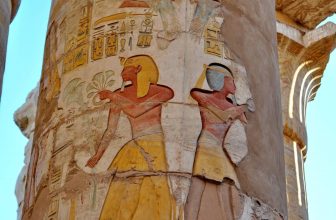If time allows, visitors to Luxor should try to see the renowned Dendera Temple Complex. From Luxor, the trip takes around an hour by cab. In one day, travelers may see both Dendera and Abydos temples on a private trip.
Dendera Temple Complex Location
The Temple is located approximately 4 kilometers from the Nile’s west bank, roughly opposite the city of Qena. Both Coptic and Muslim people live in the capital of the province and governorate of Qena (population – of 2,000,000). This village produces water pots, also known as “Qula” jars in Arabic.
Abdel Raheem El-Kenawi, a Muslim Sheik, lived his entire life in this village. His death in 1170 A.D. marked the beginning of the modern city, and his birthday is commemorated every year. For the festivities, a large number of pilgrims travel from all across Egypt. The name Qena comes from the ancient Egyptian word Qeny, which means “to bend”; the River Nile has a significant (and famous) curve here.
History and Description:
Ptolemy VIII and Queen Cleopatra II erected the Temple of Hathor in the first century B.C., and it is one of Egypt’s best-preserved temples! It was later decorated by Roman Emperors to commemorate Hathor, the goddess of motherhood, love, and music. Hathor was known to the Greeks as Aphrodite.
The well-preserved great hall, which is adorned with Hathoric columns, is reached by the first entrance, which was constructed by Roman Emperor Domitian in 80 A.D. (columns with the face of Hathor on them). The winged sun disc decorates the cornice’s upper, front border, while stone screens separate the front part from the scene depicting Roman Emperor Tiberius and other Roman emperors giving votive gifts to the Goddess of the Temple. Hathor is primarily shown, with the holy cow’s horns emerging from her head and supporting the sun’s solar disc. She wields an “Ankh” (life sign) and a scepter in her hands.
The Large hall’s interior walls are covered with amazing images portraying temple goddess sacrifices. The magnificent ceiling is covered in celestial figures! The ceiling is split into seven pieces, with the following three being the best:
- The first division, on the eastern side, portrays the Nut, the goddess of the sky, bending herself towards the earth, with the sun disc beaming over the temple and Hathor’s mask.
- A depiction of the sun boat and star goddess appears next to the first.
- The western ceiling depicts a flawless portrayal of the zodiac signs. It is one of the reasons for the temple’s popularity (the original zodiac relief is now in the Louvre Museum in Paris, France). The celestial twins, the ram, the bull, the crab, the lion, the virgin, the scales, the scorpion, the archer, the goat, the watering pots, and fish with sparkling tails are among the 12 figures. The hawk-headed deity Horus and the Ibis-headed god Thoth are pouring holy water over the king on the inner borders of the screen. This site is known as the baptism scene because it represents life and happiness.
The Second Hall: Six columns with ornate capitals and stone pedestals decorate the second hall. Small storerooms flank both sides of this hall, intended to store wine jars imported from Crete and the lush Fayoum and Kharga deserts.
The center chapel comes next, with its two altars, one for the holy boat and the other for the offerings made to Hathor. The finely sculpted reliefs on the shrine walls depict Ptolemy VIII and other kings dancing with presents to Hathor’s holy boat and her husband Horus, whose names were left blank in the oval cartouches. The king’s representatives, high priests, and a few noblemen used to assemble in the vast hall to prepare for daily ceremonies. The ceilings are adorned with stars and black soot from the Temple’s later occupants’ fires. The holy boat, the sacred wreath, the golden figure of the Goddess Hathor, and musical instruments were stored in the chambers around the sanctuary for scientific purposes.
On the right, there is a little passage that leads to a smallcryptber with a crypt, which is a fascinating place to explore. The temple’s stairwells, which lead to the temple’s roof, are adorned with magnificent motifs representing the 12 months of the year. The chapel of the deity Osiris is located on the roof’s eastern corner. Osiris rises from the dead to become the deity of the underworld, as shown on the walls. The greatest representation of the zodiac was obtained from this church.
A huge mudbrick wall encircles the whole compound, which is 40,000 square meters in size. Dendera was a rich oasis on the banks of the Nile that was populated in antiquity. Pharaoh Pepi I (ca. 2250 BC) appears to have been built on this location, and the remains of an Eighteenth Dynasty temple may still be seen (ca 1500 BC). The mammisi of Nectanebo II, the last of the native pharaohs (360–343 BC), is the earliest surviving structure in the compound today. The following are some of the amenities provided by the complex:
Dendera Temple Complex Components:
- Hathor temple (the main temple)
- Temple of the Birth of Isis
- Sacred Lake
- Sanatorium
- Mammisi of Nectanebo II
- Christian Basilica
- Roman Mammisi
- a Barque shrine
- Gateways of Domitian and Trajan
- the Roman Kiosk
Check out our Full-Day Trip to Dendera and Abydos Temples from Luxor














